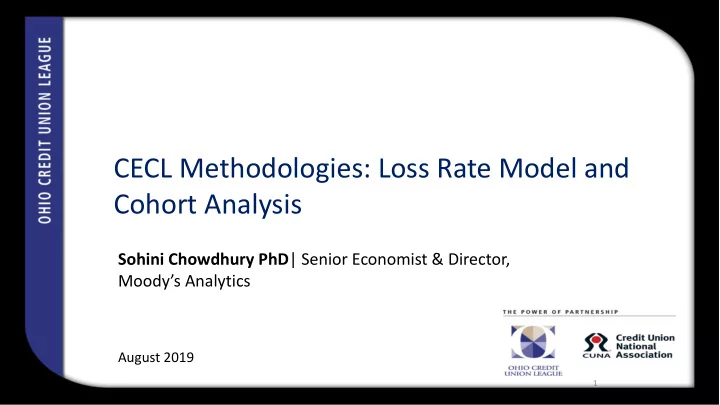

CECL Methodologies: Loss Rate Model and Cohort Analysis Sohini Chowdhury PhD | Senior Economist & Director, Moody’s Analytics August 2019 1
Agenda 1. What is Cohort Level Analysis? 2. What are Loss Rate Models? 3. Examples Showing ECL Calculation 2
What is Cohort-Level Analysis?
Different Types of Analysis Aggregate level Cohort level Loan Level Historical time series Loan age is included in All available borrower of performance the model attributes are variables is available included in the model Adding loan age in addition to loan The performance makes it a more age. The most variable is linked to granular approach granular approach macro variables relative to aggregate level model
PD PD rate for first mortgages – Aggregate vs different vintages 0.00% 0.20% 0.40% 0.60% 0.80% 1.00% 1.20% 1.40% 1.60% 1.80% 2.00% 200401 200403 200405 Vintage 2004 200407 Aggregate vs Cohort Level Analysis 200409 200411 200501 200503 200505 200507 Vintage 2005 200509 200511 200601 200603 200605 200607 200609 Vintage 2006 200611 Calendar time 200701 200703 200705 200707 200709 200711 Vintage 2007 200801 200803 200805 200807 200809 200811 200901 Aggregate 200903 200905 200907 200909 200911 201001 201003 201005 201007
Pros and Cons of Different Types of Analysis Aggregate level Cohort level Loan Level Simple data cleaning More complex than More thorough data aggregate level model cleaning is needed Very complex in terms of Easy to implement estimation Vintage differences are captured More accurate by Could be inaccurate if including all loan loan characteristics are attributes changing thru time Still easy to implement More applicable to different types of portfolios More difficult to implement
Pick Cohorts by Similar Risk Characteristics Like: » Product type » Vintage » Risk score » Geography » Collateral Type Too granular cohorts can result in too » Materiality few loan counts and statistically insignificant results » Term » Historical or Expected loss Patterns
What are Loss Rate Models? Models which predict future loss rates based on historical loss data
Loss Rate Model Pros and Cons PROS CONS ▪ Transparent calculation. Simpler data ▪ Does not incorporate the cash flow schedule requirements. ▪ Does not separate default risk from recovery ▪ If sourced from a statistical model, it can risk capture the effect of key risk drivers such as ▪ Cannot incorporate prepayment as a credit rating, loan age, size, industry, and separate input; must be factored into the other loan characteristics loss rate or remaining life ▪ Can incorporates the dependence on macroeconomic scenario ▪ Possible to calibrate losses to institution’s historical experience
Modeling Loss Rates
Common Drivers of Loss Rate Models Life Cycle Economy The age of loans Conditions every month 10 10 8 8 6 6 4 4 2 2 0 0 2010m1 2012m1 2014m1 2016m1 0 20 40 60 80 Date Age-on-books (months) Interactions Pool Quality 10 Quality & Life-cycle Parallel shifts 10 8 8 6 6 4 4 2 2 0 0 0 20 40 60 80 0 20 40 60 80 Age-on-books (months) Age-on-books (months)
Incorporate R&S Future Economic Conditions Include both national and regional forecast economic factors: Unemployment rate, % » Economic Performance 10 Baseline Consensus GDP Growth, Disposable Income Growth S1 S2 S3 S4 » Labor Markets S5 S6 8 Unemployment, Job/Wage/Salary Growth S7 S8 » Demographics Population, Number of Households, Migrations etc. 6 » Real Estate Markets Home Prices, Home Sales, Housing Starts, Permits 4 » Financial Markets Federal Reserve Interest Rates, Equity Mark Indexes 2 06 10 14 18 22 26 30 34 38 42 46
Capture Local Economic Conditions Unemployment rate, % 12 State National 10 8 2019Q3 6 4 2 Metro 0 2019Q3 F 00 02 04 06 08 10 12 14 16 18
Which metro area has the LOWEST unemployment rate?
Which metro area has the HIGHEST unemployment rate?
Using Loss Rates in CECL Calculation
Using Loss Rates to Calculate ECL » Unpaid Principal Balance = $1,000,000 » Amortized Cost = $ 986,732 » Remaining maturity = 5 years » Fixed Coupon Rate = 5% » Effective Interest Rate = 5.5% » Amortization type = Linear » Payment Frequency = Annual » Annual Prepayment Rate= 5%
Loss Rate Annualized Approach Assumptions Formula Output » Amortized Cost = $ 986,732 Allowance Allowance » Remaining maturity = 5 years = EAD X = 986,732 x 0.0025 x 5 » Fixed Coupon Rate = 5% Annualized Loss Rate X = 12,334 » Amortization type = Linear Remaining Lifetime » Annualized Loss Rate = 0.25%
Loss Rate Lifetime Approach Assumptions Formula Output » Amortized Cost = $986,732 Allowance Allowance » Remaining maturity = 5 years = EAD X Lifetime Loss = 986,732 x 0.042 » Amortization type = Linear Rate = 41,443 » Lifetime Loss Rate = 4.2%
Recommend
More recommend